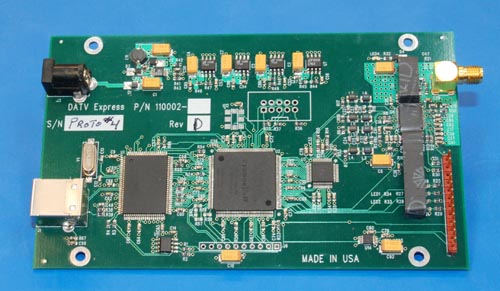After Dayton, Art used this board to finish up a few tests. The maximum RF power output of this prototype board is 10 dBm. Proto #3 board had an output of 18 dBm. The modulator chip runs hot. The case temperature of the IQ modulator chip runs at +165 degrees F (74 C) with air ambient at 75 degrees F…if no heatsink is used. 165 F is hot but certainly within design limits. Art then tested with a low profile copper strip unit from Aavid called a "thin-fin" heat sink which looks like a small band aid. The area where the band aid gauze pad is located is a self adhesive peel and stick area. Just press it on to the IC top. [NOTE - the band-aid heatsinks can be seen as black strips on the right side of the board in the photo below...next to the RF connector.] The addition of one about 3/8" wide and 2" long lowered the IC case temperature to about +128 degrees. Charles G4GUO had also tested that a metal chassis (box) with metal-standoffs for mounting the board reduces the modulator case temperature nicely.
After these tests, Art shipped the Proto#4 board off to Ken W6HHC. Now the pressure is on for getting Ken’s Ubuntu skills up to speed to help beta testing the 32-bit version of code that Charles has been working on. Art plans to begin assembling Proto #5 board this coming week.
Prototype #4 board arrives at QTH of Ken W6HHC

The team was able to obtain confirmation from two different CE Mark EMI testing labs (one lab in Europe and one lab in USA) that the DATV-Express exciter board does NOT have to undergo EMI testing. The board-level exciter module product is excluded by the R&TTE Directive 1999/5/EC because it is considered a Ham radio component for a kit (add power-supply and comb band-pass filter and RF amplifiers and cabinet and software….etc.). The directive states that licensed "radio amateurs are considered qualified in radio communications, and it is a condition of their licence that they will not cause interference to others (kits of components sold for assembly by radio amateurs are not regarded as ‘commercially’ available, ie they are not sold to the general public, so they do not have to meet the provisions of the regulations)".
Charles G4GUO has been mainly working on the libusb-1.0 interface as he is/was unhappy with its performance. Back in March under Ubuntu 32 bit, Charles was getting the occasional hang at start up. However under Ubuntu 64 bit it was not working at all. This all worked fine when using Fedora linux and an earlier version of libusb. Charles now reports that he is beginning to see the light at the end of the tunnel…and has it working much better now.
Other than that Charles has added software to provide 2/3/4 Mhz DVB-T. Until he buys a receive dongle for those Modes, he will not be able to test them but they are scaled versions of standard DVB-T so they should work.
Finally, Charles has also been using the 47 dB attenuator built into the DATV-Express modulator chip to provide a weak signal on 70 cms to test his 70 cms DATV RX setup. (There is a BATC ATV contest on the weekend of 8/9 June).
73…de Ken W6HHC